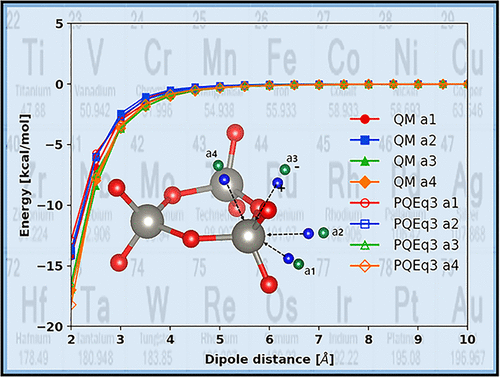当前位置:
X-MOL 学术
›
J. Phys. Chem. A
›
论文详情
Our official English website, www.x-mol.net, welcomes your feedback! (Note: you will need to create a separate account there.)
Polarizable Charge Equilibration Model for Transition-Metal Elements
The Journal of Physical Chemistry A ( IF 2.9 ) Pub Date : 2018-11-09 00:00:00 , DOI: 10.1021/acs.jpca.8b07290 Soonho Kwon 1 , Saber Naserifar 2 , Hyuck Mo Lee 1 , William A. Goddard 2
The Journal of Physical Chemistry A ( IF 2.9 ) Pub Date : 2018-11-09 00:00:00 , DOI: 10.1021/acs.jpca.8b07290 Soonho Kwon 1 , Saber Naserifar 2 , Hyuck Mo Lee 1 , William A. Goddard 2
Affiliation

|
The polarizable charge equilibration (PQEq) method was developed to provide a simple but accurate description of the electrostatic interactions and polarization effects in materials. Previously, we optimized four parameters per element for the main group elements. Here, we extend this optimization to the 24 d-block transition-metal (TM) elements, columns 4–11 of the periodic table including Ti–Cu, Zr–Ag, and Hf–Au. We validate the PQEq description for these elements by comparing to interaction energies computed by quantum mechanics (QM). Because many materials applications involving TM are for oxides and other compounds that formally oxidize the metal, we consider a variety of oxidation states in 24 different molecular clusters. In each case, we compare interaction energies and induced fields from QM and PQEq along various directions. We find that the original χ and J parameters (electronegativity and hardness) related to the ionization of the atom remain valid; however, we find that the atomic radius parameter needs to be close to the experimental ionic radii of the transition metals. This leads to a much higher spring constant to describe the atomic polarizability. We find that these optimized parameters for PQEq provide accurate interaction energies compared to QM with charge distributions that depend in a reasonable way on the coordination number and oxidation states of the transition metals. We expect that this description of the electrostatic interactions for TM will be useful in molecular dynamics simulations of inorganic and organometallic materials.
中文翻译:

过渡金属元素的极化电荷平衡模型
开发了可极化电荷平衡(PQEq)方法,以提供对材料中静电相互作用和极化效应的简单但准确的描述。以前,我们为主要组元素优化了每个元素四个参数。在这里,我们将此优化扩展到元素周期表的4 d块过渡金属(TM)元素的第4-11列,包括Ti-Cu,Zr-Ag和Hf-Au。通过与量子力学(QM)计算的相互作用能进行比较,我们验证了这些元素的PQEq描述。因为涉及TM的许多材料应用都是用于氧化物和其他形式上会氧化金属的化合物,所以我们考虑了24种不同分子簇中的各种氧化态。在每种情况下,我们都将比较QM和PQEq沿不同方向的相互作用能和感应场。与原子电离有关的J参数(电负性和硬度)仍然有效;但是,我们发现原子半径参数必须接近过渡金属的实验离子半径。这导致描述原子极化率的弹簧常数高得多。我们发现,与QM相比,PQEq的这些优化参数可提供准确的相互作用能,且电荷分布以合理的方式取决于过渡金属的配位数和氧化态。我们希望这种对TM的静电相互作用的描述将在无机和有机金属材料的分子动力学模拟中有用。
更新日期:2018-11-09
中文翻译:

过渡金属元素的极化电荷平衡模型
开发了可极化电荷平衡(PQEq)方法,以提供对材料中静电相互作用和极化效应的简单但准确的描述。以前,我们为主要组元素优化了每个元素四个参数。在这里,我们将此优化扩展到元素周期表的4 d块过渡金属(TM)元素的第4-11列,包括Ti-Cu,Zr-Ag和Hf-Au。通过与量子力学(QM)计算的相互作用能进行比较,我们验证了这些元素的PQEq描述。因为涉及TM的许多材料应用都是用于氧化物和其他形式上会氧化金属的化合物,所以我们考虑了24种不同分子簇中的各种氧化态。在每种情况下,我们都将比较QM和PQEq沿不同方向的相互作用能和感应场。与原子电离有关的J参数(电负性和硬度)仍然有效;但是,我们发现原子半径参数必须接近过渡金属的实验离子半径。这导致描述原子极化率的弹簧常数高得多。我们发现,与QM相比,PQEq的这些优化参数可提供准确的相互作用能,且电荷分布以合理的方式取决于过渡金属的配位数和氧化态。我们希望这种对TM的静电相互作用的描述将在无机和有机金属材料的分子动力学模拟中有用。



























 京公网安备 11010802027423号
京公网安备 11010802027423号